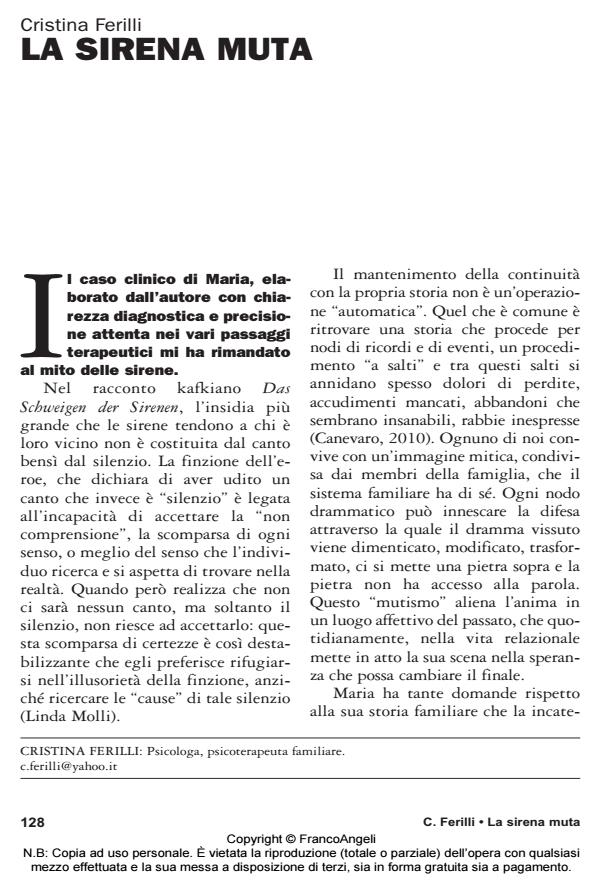La sirena muta
Titolo Rivista PSICOBIETTIVO
Autori/Curatori Cristina Ferilli
Anno di pubblicazione 2015 Fascicolo 2015/1
Lingua Italiano Numero pagine 6 P. 128-133 Dimensione file 96 KB
DOI 10.3280/PSOB2015-001009
Il DOI è il codice a barre della proprietà intellettuale: per saperne di più
clicca qui
Qui sotto puoi vedere in anteprima la prima pagina di questo articolo.
Se questo articolo ti interessa, lo puoi acquistare (e scaricare in formato pdf) seguendo le facili indicazioni per acquistare il download credit. Acquista Download Credits per scaricare questo Articolo in formato PDF

FrancoAngeli è membro della Publishers International Linking Association, Inc (PILA)associazione indipendente e non profit per facilitare (attraverso i servizi tecnologici implementati da CrossRef.org) l’accesso degli studiosi ai contenuti digitali nelle pubblicazioni professionali e scientifiche
Il contributo propone una rilettura del caso clinico di Maria attraverso una prospettiva sistemico-relazionale. Il racconto kafkiano Das Shweingen der Sirenen viene utilizzato come metafora della sofferenza umana amplificata dalla solitudine di ciò che si vive, dell’impossibilità della condivisione del significato di ciò che di traumatico è accaduto. Il mantenimento della continuità con la propria storia non è un’operazione "automatica". Quel che è comune è ritrovare una storia che procede per nodi di ricordi e di eventi, un procedimento "a salti" e tra questi salti si annidano spesso dolori di perdite, accudimenti mancati, abbandoni che sembrano insanabili, rabbie inespresse. L’arte terapeutica ricuce il significato del dramma vissuto. Particolare attenzione viene posta sulla definizione della cornice trigenerazionale, fondamentale specialmente con persone con passati così tristi e dolorosi; sulla storia familiare; sull’accogliere le frustrazioni relazionali della paziente per poi promuovere le competenze relazionali rilevanti; sull’importanza dell’utilizzo in terapia del linguaggio analogico per esplorare la dimensione mitica e degli oggetti fluttuanti, nello specifico "le maschere". Il lavoro si conclude salutando Maria con una restituzione: il racconto metaforico.
Parole chiave:Psicoterapia sistemica; cornice trigenerazionale; storia familiare; mito; linguaggio analogico; oggetti fluttuanti; racconto metaforico
Cristina Ferilli, La sirena muta in "PSICOBIETTIVO" 1/2015, pp 128-133, DOI: 10.3280/PSOB2015-001009